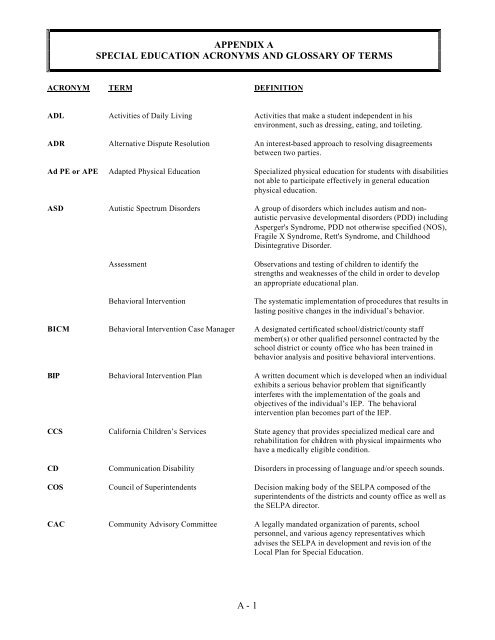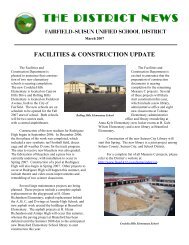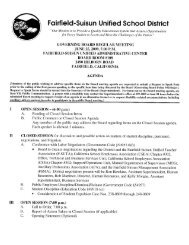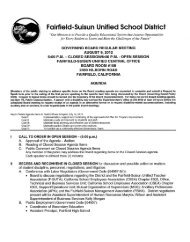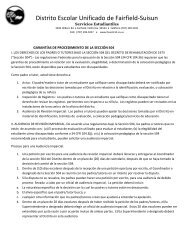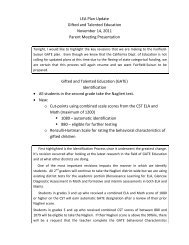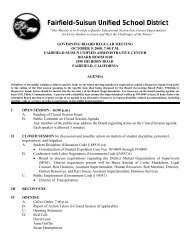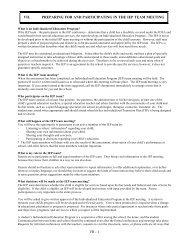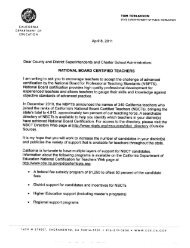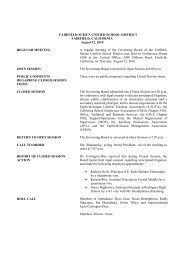Special Education Acronyms and Glossary of Terms
Special Education Acronyms and Glossary of Terms
Special Education Acronyms and Glossary of Terms
You also want an ePaper? Increase the reach of your titles
YUMPU automatically turns print PDFs into web optimized ePapers that Google loves.
APPENDIX A<br />
SPECIAL EDUCATION ACRONYMS AND GLOSSARY OF TERMS<br />
ACRONYM TERM DEFINITION<br />
ADL Activities <strong>of</strong> Daily Living Activities that make a student independent in his<br />
environment, such as dressing, eating, <strong>and</strong> toileting.<br />
ADR<br />
Ad PE or APE<br />
ASD<br />
BICM<br />
BIP<br />
CCS<br />
CD<br />
COS<br />
CAC<br />
Alternative Dispute Resolution<br />
Adapted Physical <strong>Education</strong><br />
Autistic Spectrum Disorders<br />
Assessment<br />
Behavioral Intervention<br />
Behavioral Intervention Case Manager<br />
Behavioral Intervention Plan<br />
California Children’s Services<br />
Communication Disability<br />
Council <strong>of</strong> Superintendents<br />
Community Advisory Committee<br />
A - 1<br />
An interest-based approach to resolving disagreements<br />
between two parties.<br />
<strong>Special</strong>ized physical education for students with disabilities<br />
not able to participate effectively in general education<br />
physical education.<br />
A group <strong>of</strong> disorders which includes autism <strong>and</strong> nonautistic<br />
pervasive developmental disorders (PDD) including<br />
Asperger's Syndrome, PDD not otherwise specified (NOS),<br />
Fragile X Syndrome, Rett's Syndrome, <strong>and</strong> Childhood<br />
Disintegrative Disorder.<br />
Observations <strong>and</strong> testing <strong>of</strong> children to identify the<br />
strengths <strong>and</strong> weaknesses <strong>of</strong> the child in order to develop<br />
an appropriate educational plan.<br />
The systematic implementation <strong>of</strong> procedures that results in<br />
lasting positive changes in the individual’s behavior.<br />
A designated certificated school/district/county staff<br />
member(s) or other qualified personnel contracted by the<br />
school district or county <strong>of</strong>fice who has been trained in<br />
behavior analysis <strong>and</strong> positive behavioral interventions.<br />
A written document which is developed when an individual<br />
exhibits a serious behavior problem that significantly<br />
interferes with the implementation <strong>of</strong> the goals <strong>and</strong><br />
objectives <strong>of</strong> the individual’s IEP. The behavioral<br />
intervention plan becomes part <strong>of</strong> the IEP.<br />
State agency that provides specialized medical care <strong>and</strong><br />
rehabilitation for children with physical impairments who<br />
have a medically eligible condition.<br />
Disorders in processing <strong>of</strong> language <strong>and</strong>/or speech sounds.<br />
Decision making body <strong>of</strong> the SELPA composed <strong>of</strong> the<br />
superintendents <strong>of</strong> the districts <strong>and</strong> county <strong>of</strong>fice as well as<br />
the SELPA director.<br />
A legally m<strong>and</strong>ated organization <strong>of</strong> parents, school<br />
personnel, <strong>and</strong> various agency representatives which<br />
advises the SELPA in development <strong>and</strong> revis ion <strong>of</strong> the<br />
Local Plan for <strong>Special</strong> <strong>Education</strong>.
ACRONYM TERM DEFINITION<br />
CBI<br />
DIS<br />
EC<br />
ESY<br />
FAPE<br />
IEP<br />
IEPT<br />
Community Based Instruction<br />
Complaint Compliance<br />
Designated Instruction <strong>and</strong> Services<br />
Differential Pr<strong>of</strong>iciency St<strong>and</strong>ards<br />
Due Process<br />
California <strong>Education</strong> Code<br />
Extended School Year<br />
Fair Hearing<br />
Free <strong>and</strong> Appropriate Public <strong>Education</strong><br />
Inclusive <strong>Education</strong><br />
Supported <strong>Education</strong><br />
Full Inclusion<br />
Individualized <strong>Education</strong> Program<br />
Individualized <strong>Education</strong> Program Team<br />
A - 2<br />
A form <strong>of</strong> instruction in which IEP goals are met in a<br />
“natural” environment within the community. For<br />
example, math, sequencing, travel, <strong>and</strong> social skills may be<br />
developed through a trip to the grocery store.<br />
The process <strong>of</strong> resolving an alleged violation <strong>of</strong> special<br />
education laws or regulations.<br />
Also known as related services, specialized instruction,<br />
<strong>and</strong>/or support services identified through an assessment<br />
provided as necessary for a child to benefit from his/her<br />
educational program.<br />
Alternative performance st<strong>and</strong>ards designed for special<br />
education students to permit them to meet graduation<br />
requirements.<br />
All procedural safeguards <strong>of</strong> P.L.94-192 <strong>and</strong> related laws<br />
<strong>and</strong> regulations. A process for resolving disagreements<br />
regarding IEP issues.<br />
The body <strong>of</strong> regulations which governs education in the<br />
State <strong>of</strong> California.<br />
The special education program provided between school<br />
sessions when the IEP team determines they are needed to<br />
prevent regression <strong>of</strong> skills.<br />
A formal hearing that is requested by parents or school<br />
district personnel. Issues that may be considered under the<br />
fair hearing procedure are limited to eligibility, assessment,<br />
the individualized education program, <strong>and</strong> placement <strong>of</strong><br />
individuals with exceptional needs. A specially trained<br />
hearing <strong>of</strong>ficer resolves the issues.<br />
Every school-age child with a disability is entitled to an<br />
education that meets his/her individual needs, which is at<br />
no cost to parents.<br />
A process in which a continuum <strong>of</strong> supported education<br />
options are considered for all students <strong>and</strong> which provides<br />
for equal access to the school community. Placement<br />
decisions <strong>and</strong> programming are based on the agreed upon<br />
identified educational outcomes.<br />
A written document, m<strong>and</strong>ated by law, that defines a<br />
child’s disability, states current levels <strong>of</strong> educational<br />
performance, describes educational needs, <strong>and</strong> specifies<br />
annual goals <strong>and</strong> short-term objectives/benchmarks, <strong>and</strong> an<br />
evaluation <strong>and</strong> progress reporting schedule.<br />
A minimum <strong>of</strong> four individuals who meet to develop <strong>and</strong><br />
review the student’s IEP. The team is composed <strong>of</strong> an<br />
administrator or his/her designee, the student’s special<br />
education <strong>and</strong> general education teacher, <strong>and</strong> the parents.<br />
Other members may include the student, those who have<br />
assessed the student, <strong>and</strong> others as appropriate.
ACRONYM TERM DEFINITION<br />
IFSP<br />
ITP<br />
IDEA 97<br />
IWEN<br />
LAC<br />
LRE<br />
LEP<br />
LEA<br />
LP<br />
LI<br />
Individualized Family Plan Service<br />
Individualized Transition Plan<br />
Individuals With Disabilities <strong>Education</strong><br />
Act, Reauthorized in 1997<br />
Individuals With Exceptional Needs<br />
Local Advisory Committee<br />
Least Restrictive Environment<br />
Limited English Pr<strong>of</strong>iciency<br />
Local <strong>Education</strong> Agency<br />
(Now known as Public <strong>Education</strong> Agency)<br />
Local Plan<br />
Low Incidence Disabilities<br />
A - 3<br />
An individualized education plan for an infant or which is<br />
developed by the team to identify strengths, needs,<br />
concerns, <strong>and</strong> priorities for early intervention services for<br />
students under 3 years <strong>of</strong> age.<br />
That portion <strong>of</strong> the IEP that specifies activities <strong>and</strong> services<br />
for students age 14 <strong>and</strong> older to facilitate their transition<br />
from high school to the adult world. Developed at an IEP<br />
meeting, the ITP includes parents, student, school<br />
personnel, <strong>and</strong> agency representatives as appropriate.<br />
An amendment to <strong>and</strong> reauthorization <strong>of</strong> Public Law 94-<br />
142, the <strong>Education</strong> for All H<strong>and</strong>icapped Children Act <strong>of</strong><br />
1975, which m<strong>and</strong>ates a free, appropriate public education<br />
for all children with exceptional needs.<br />
Individuals from infancy through age 22 identified by an<br />
individualized education program team as having a<br />
disability or condition that requires specialized instruction<br />
<strong>and</strong>/or services.<br />
A local branch <strong>of</strong> the SELPA Community Advisory<br />
Committee (CAC) which meets in each district on a<br />
monthly basis to discuss special education issues <strong>and</strong><br />
concerns. A representative from each LAC attends <strong>and</strong><br />
gives input to the monthly CAC meetings <strong>and</strong> takes CAC<br />
information back to the LAC.<br />
A learning environment for a student with exceptional<br />
needs that meets his learning needs while providing<br />
maximum interaction with the general school population in<br />
a manner appropriate to the needs <strong>of</strong> the student <strong>and</strong> his/her<br />
peers.<br />
Students whose primary language is other than English,<br />
who lack competence in the English language, <strong>and</strong> for<br />
whom linguistically appropriate goals <strong>and</strong> objectives are<br />
developed.<br />
A school district providing special education service within<br />
the SELPA. There are five LEAs within our SELPA.<br />
The document developed by staff <strong>and</strong> the community that<br />
describes the delivery <strong>of</strong> special education programs <strong>and</strong><br />
services which will be provided by all districts in the<br />
SELPA to meet the educational needs <strong>of</strong> eligible<br />
individuals with exceptional needs. Each SELPA develops<br />
a new plan every four years that is approved by the State<br />
Department <strong>of</strong> <strong>Education</strong>.<br />
Those severe disabling conditions with an expected<br />
incidence rate <strong>of</strong> less than one percent <strong>of</strong> the total statewide<br />
enrollment in kindergarten through grade 12. These<br />
conditions are hearing impairments, vision impairments,<br />
severe orthopedic impairments, or any combination <strong>of</strong><br />
these.
ACRONYM TERM DEFINITION<br />
NPS<br />
O & M<br />
OHI<br />
OI<br />
PDD<br />
PEA<br />
PL 99-547<br />
RSP<br />
SEC<br />
SED<br />
SELPA<br />
Multidisciplinary Team<br />
Non-Public School<br />
Orientation <strong>and</strong> Mobility<br />
Other Health Impaired<br />
Orthopedic Impairment<br />
Pervasive Developmental Disorders<br />
Public <strong>Education</strong> Agency<br />
Public Law 99-547<br />
Referral<br />
Related Services<br />
Resource <strong>Special</strong>ist Program<br />
<strong>Special</strong> <strong>Education</strong> Council<br />
Seriously Emotionally Disturbed<br />
<strong>Special</strong> <strong>Education</strong> Local Plan Area<br />
A - 4<br />
Using a combination <strong>of</strong> the skills <strong>of</strong> several persons with<br />
specialized areas <strong>of</strong> training for a common purpose, i.e.,<br />
assessment <strong>of</strong> a student to determine eligibility for services.<br />
Licensed private, nonsectarian school that provides special<br />
education programs <strong>and</strong> services for a child whose needs<br />
cannot be served within the SELPA.<br />
<strong>Special</strong>ized instruction for students with significant visual<br />
impairments to develop spatial awareness skills that enable<br />
them to move through space <strong>and</strong> travel independently.<br />
An eligibility category that specifies certain chronic <strong>and</strong><br />
acute health problems that result in the students having<br />
limited strength, vitality, <strong>and</strong> alertness which adversely<br />
affect his/her educational performance.<br />
A physical disability impairment that adversely affects a<br />
child’s educational performance, such as congenital<br />
anomalies, impairments caused by disease <strong>and</strong> from other<br />
causes.<br />
A term defined in DSM-IV which encompasses Autistic<br />
Disorder (Autism) as well as the Non-Autistic PDDS:<br />
Asperger's Syndrome, PDD-NOS, Fragile X, <strong>and</strong> Rett's<br />
Syndrome as well as Childhood Disintegrative Disorder.<br />
See LEA above.<br />
<strong>Education</strong> <strong>of</strong> the H<strong>and</strong>icapped Act Amendments <strong>of</strong> 1986<br />
provides for coordination <strong>of</strong> early intervention services for<br />
all young children with disabilities (age 0-3).<br />
The request to identify <strong>and</strong> assess a child’s possible special<br />
education needs; a referral may be made by a parent,<br />
teacher, medical personnel, or anyone with specific<br />
knowledge <strong>of</strong> the child.<br />
Those additional services that a child requires in order to<br />
benefit from his educational program.<br />
Provides students with special education instruction for a<br />
portion <strong>of</strong> their day. Students may receive RSP services in<br />
general education classrooms, in a special education<br />
classroom, or in both settings.<br />
Decision making body composed <strong>of</strong> directors <strong>of</strong> special<br />
education <strong>and</strong> SELPA director.<br />
An emotional problem that has existed for a marked degree<br />
<strong>and</strong> over a long period <strong>of</strong> time which interferes with<br />
learning.<br />
A single large school district or a group <strong>of</strong> smaller school<br />
districts within a geographic area in accordance with the<br />
law to coordinate the administration <strong>and</strong> delivery <strong>of</strong> special<br />
education services.
ACRONYM TERM DEFINITION<br />
SDC<br />
Sp. Ed.<br />
SLD<br />
SLI<br />
SST<br />
VI<br />
VocEd<br />
<strong>Special</strong> Day Class<br />
<strong>Special</strong> <strong>Education</strong><br />
Specific Learning Disability<br />
Speech/Language Impairment<br />
Student Study Team<br />
Child Study Team<br />
Surrogate Parent<br />
Transdisciplinary<br />
Visual Impairment<br />
Vocational <strong>Education</strong><br />
A - 5<br />
An instructional setting through which the student receives<br />
special education instruction.<br />
Instruction that is specifically designed for each individual<br />
student to meet his unique needs. Students who receive<br />
special education must meet eligibility requirements under<br />
specific disability categories as specified in federal <strong>and</strong><br />
state law <strong>and</strong> regulations.<br />
A disorder in one or more <strong>of</strong> the basic psychological<br />
processes involved in underst<strong>and</strong>ing or using spoken <strong>and</strong>/or<br />
written language, as well as a severe discrepancy between<br />
intellectual ability <strong>and</strong> achievement.<br />
Difficulty in underst<strong>and</strong>ing or using language to the extent<br />
that it interferes with learning; also a disability category<br />
which includes severe language disorders, hearing<br />
impairment, <strong>and</strong> language delay.<br />
A general education process designed to make instructional<br />
modifications within the general education program when a<br />
student is experiencing difficulties.<br />
A person selected by the local school district to act as the<br />
parent after determination that the child's actual parent(s)<br />
cannot be located. Or after the child has been made a ward<br />
<strong>of</strong> the court, the court has removed the parent's right to<br />
make educational decisions for the child.<br />
A type <strong>of</strong> assessment approach in which the family <strong>and</strong><br />
pr<strong>of</strong>essionals work together to train each other in their area<br />
<strong>of</strong> expertise.<br />
A student whose visual acuity, even with correction,<br />
adversely affects educational performance. This includes<br />
students who are blind or have limited vision.<br />
Programs <strong>and</strong> curriculum designed to assist students in<br />
developing self-confidence <strong>and</strong> vocational competencies to<br />
secure future employment <strong>and</strong> become productive members<br />
<strong>of</strong> their community.


